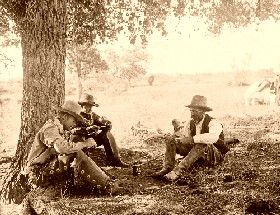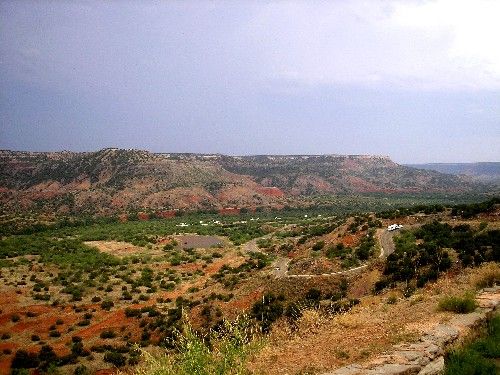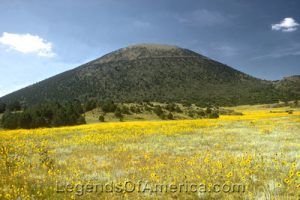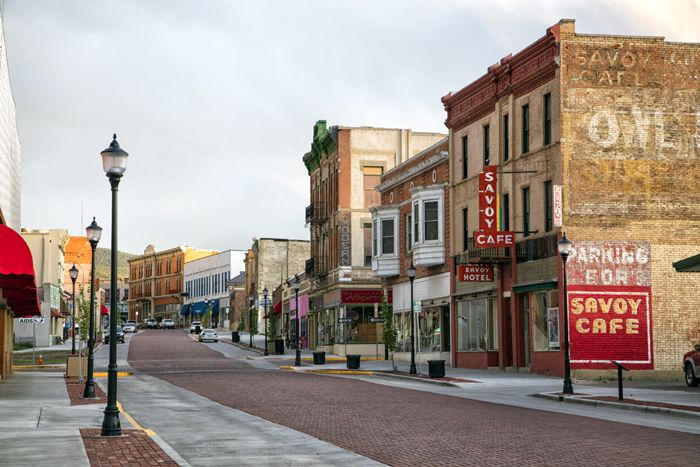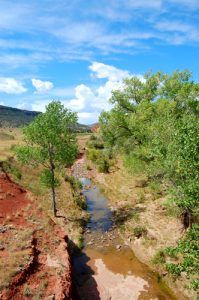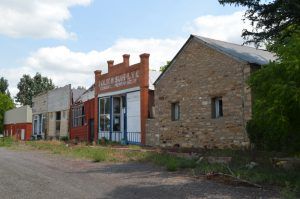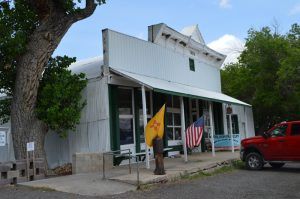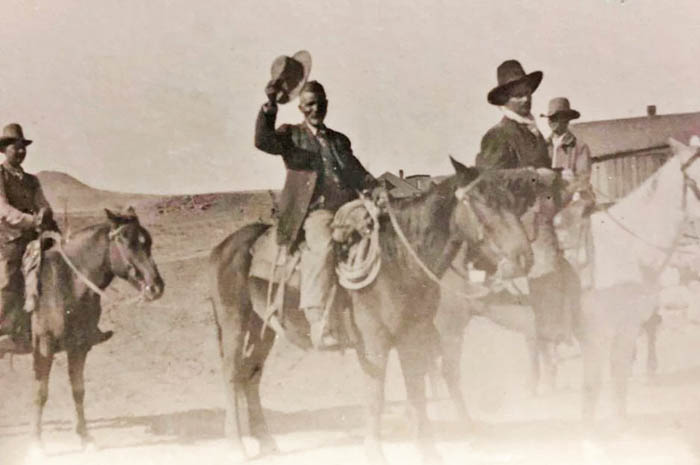By Matt Doherty

George McJunkin, about 1907.
George McJunkin was born into slavery in Rogers Prairie, Texas, on his master, John Sanders McJunkin’s ranch, ten years before the Civil War began. George’s father, who had purchased his freedom years before, was a blacksmith and raised mules for the freighters hauling buffalo hide east from the Indian country.
During the war, while all the white cowboys were away fighting, George learned to ride from the Mexican vaqueros that stayed behind. After the war ended, there was an abundance of cattle roaming Texas. The cattle had multiplied to nearly five million head while men were away fighting. Cowboys would gather the cattle and drive them north to the railheads to be shipped to big cities in the east, where they were slaughtered for meat.
At night George would sneak off to the river to listen to stories around the fire from the Cowboys driving the Longhorns north to Abilene, Kansas. George dreamed of the freedom of being a cowboy and was amazed by the equality the black, white, and Mexican cowboys shared.
One night in the spring of 1867, George gathered up two ropes and an extra pair of wool pants, stuffed a couple of pieces of cornbread into a gunny sack, and headed barefooted down the dirt road. George stopped at the first house after sunup and told them to inform his parents of his whereabouts “tell them I’m going to be a cowboy and to look for school.”
As he went further down the road, he passed a group of horses and one old mule that had strayed from the McJunkin ranch. Rather than walking, George decided he would borrow a horse since master McJunkin did owe him for all the free labor. Using his better judgment, he knew he would be less likely to attract attention if he rode a mule. He fashioned a halter out of his rope and rode down the road. Along the way, he stopped and helped dig a well for a couple of white settlers building a sod house. The man paid him a fistful of quarters, and with that, he purchased his first pair of boots when he arrived in Comanche. He was hired as a Horse Wrangler for an outfit camped outside of town.
The Cowboys were driving longhorns north to Abilene to the railheads to be shipped the east. Along the trail, George learned how to handle horses during the day, and the Cowboys taught him to read the night sky. Once they reached Abilene, George bought some new clothes and his first horse. But instead of heading north with the other black cowboys, he decided to take up his boss’s offer to cowboy for him the next year and headed back south to Texas for the winter. As he was skirting around Comanche, George saw a familiar old mule that he caught and returned to the McJunkin ranch.
Across the Staked Plains
Upon arriving home, George was offered a job by Gideon Roberts after he watched George make an outstanding bronc ride on a big grey mare. Roberts and three other men drove 700 horses across The Comanche-controlled staked plains of West Texas to New Mexico to sell on the Santa Fe Trail. Once they reached Palo Duro Canyon in West Texas, they built a cabin and started rounding up more horses for the herd.
One day, while George was alone in the canyon, he heard the sound of thundering hooves. It was a group of Comanche Indians stealing all of the horses. George’s saddle horse broke loose in the frenzy and joined the stampeding mustangs. The Indians rode up to George realizing he was unarmed one laughed at him and said: “black Mexican can walk now.” They held their rifles over their heads, spun the ponies around, and rode off after the newly acquired herd.
When Roberts and the other men returned, they started the long task of reassembling the herd. They only saw one more Indian that winter. Roberts shot him and had George bury the Indian so others would not seek reprisal. It seems Indians got their revenge, though, as they found the lifeless body of Gideon‘s brother, who had not returned from a turkey hunt. He had been bludgeoned to death with a tomahawk.
Dry Cimmaron in the Hi-Low country
Once the herd reached the original numbers before the Indian raid, they headed for New Mexico. Upon arriving in the Hi-low country of northeastern New Mexico, George fell in love with the Dry Cimarron Valley, or the Seco Cimarron as the Mexican sheepherders called it. George climbed up the slopes of Capulin Mountain, an extinct volcano that jetted out of the landscape like an enormous anthill giving a commanding view of the valley. The breathtaking view of the green meadows full of wild Iris nestling the Juniper blanketed mesa reminded him of the promised land in the Bible.
Besides the Comanche, the only other inhabitants of the valley were the Spanish sheepherders. Two of them, Carlitos Cornay and Candido Archuleta, who also were the first cattleman arriving in the area with the “Dutch outfit,” became George’s closest friends. George spent his days exploring the river and following the horses as they grazed on the open range. There were few travelers along the Cimarron cut-off of the Santa Fe Trail. Most stayed on the main route, and there were few others in need of horses in the area.
Following Charles Goodnight and the thousands of longhorns heading north to the mines and military outpost, Roberts had George drive the horses over Trinchera pass into Colorado, where they set up the first horse ranch a few miles east of Trinidad. The ranch was located on the Purgatory River near the Mountain branch of the Santa Fe Trail. Robert sold the horses as fast as George could break them, and it wasn’t long before Roberts’ horses trained by George were a highly sought-after commodity.
Trinidad, at this time, was a rough lawless town employing Bat Masterson for a time as sheriff. Even Billy the Kid rode into town looking to kill four doctors but fortunately was talked out of it by Sister Blandina Segale (Catholic nun who is currently being canonized becoming America’s next saint). George would only stay in town long enough to get supplies and quickly headed back to the ranch. On one of his supply runs, he bought a fiddle. George loved to play the fiddle at the old Trinchera Plaza at night for his friends when he wasn’t taking reading and writing lessons from Gideon Robert’s sons Emmett and Coke. He would teach the boys how to break horses in exchange for his lessons.
Dr. Owen and the “101”
George’s reputation grew, and he was asked to help with the round-up at the “101” near No Man’s Land, where Oklahoma joined New Mexico territory down the Dry Cimarron River. After the roundup was over, Ben Smith, foreman of the 101, asked George if he would like a job working for Dr. Thomas Owen, former mayor of Trinidad and partner of the “101”. The doctor was starting a new place, Hereford Park. George didn’t hesitate, knowing the doctor raised some of the best horses in that part of the west, and it was located at the headwaters of the Dry Cimarron, George’s beloved promised land.
George soon found himself with the doctor and his brother John, burying the three sacks of gold from the sale of the cattle George trailed up from Texas to Herford Park. The three men were worried that the Coe Gang, who operated out of no man’s land, had heard of the sale and would surely be looking for the gold. George would watch it until the following spring when they returned to purchase more cattle.
George’s responsibilities grew as Dr. Owen spent more time away from Hereford Park. He oversaw the crew of men that built the big house and barn and would teach the Doctors sons, Tom and Ben, the art of bronc riding, rewarding them with a new pair of spurs just as he did for the Roberts boys and the many others that he taught to ride over the years.
One night after dinner, Dr. Owen told George that this will be the last roundup before they fenced in the open range, and he was to be the wagon boss. He was reluctant, for he would be in charge of 20 cowboys, 2000 head of cattle, and 200 head of horses. But Dr. Owen reassured him he was the best cowboy in New Mexico, and there wasn’t another man better suited for the job. And it didn’t take long to earn the respect of the other Texas cowboys that resented working for a black man.
In the fall of 1889, George and 14 cowboys from the “Cross L,” “Pitchfork” and the “101” were caught in a ten-day blizzard outside of Clayton. The storm was so severe it wiped out most of the 1200 head of steers and the Pitchfork’s entire 200-head Remuda. If it weren’t for George taking control on the third day and leading them to the Bramlett Ranch, the Cowboys would’ve met the same fate.
Two years after the blizzard, Dr. Owen asked George to hitch up the buggy and take him into Folsom to meet the train. By then, the doctor was old and sick, and this would be their last ride together. George helped him onto the train, and the doctor said: “thank you, thank you, I know you’ll take good care of things.” And with that, the train pulled out, and his friend and teacher was dead before it arrived in Trinidad. George then had a big responsibility as the father figure for Tom and Ben, who were too young to run the ranch alone.
George caught the eye of their new neighbor Bill Jack an important New Mexico cattleman who owned the XYZ Ranch, a mile north of Hereford Park. It was here on the Crowfoot Ranch that George got his next opportunity.
Managing the XYZ
Mr. Jack sent George on the train to Silver City to round up his herd and bring it back to the Crowfoot. George was riding into Silver City when he saw four men beating a man. He pulled out his rifle and said: “It’s an awful hot day to be doing that kind of work, isn’t it?” Startled, the men spun around, but George’s horse spooked, leaving George on the ground. The bandits escaped during the commotion, but the man George just saved was a lieutenant in the Cavalry stationed at Fort Bayard. The men that accosted the lieutenant were after the payroll, and the Lieutenant was so thankful that he gave George his telescope. He would use it and the transit he got from his friend, the owner of the TO Ranch, to fence the open range.
This would not be his only encounter with outlaws. George was riding back to the Crowfoot Ranch from Folsom when he came upon a camp of strange men. After visiting with them, George grew suspicious. The next day his suspicion was right. A train was robbed between Folsom and Des Moines, and the gang made off with a large sum of gold and silver. McJunkin took sheriff George Titsworth to the spot where he had seen the men camping. Together, he and Tittsworth found a note shredded into pieces. Titsworth took the paper back to the store in Folsom (today the Folsom Museum), where they pieced it together.
From the information in this letter, Tittsworth concluded that they were headed for Cimarron. He loaded the posse on the train and cut the outlaws off in Turkey Canyon near Cimarron. A shoot-out commenced that left sheriff Ed Farr dead but two of the outlaws, Sam Ketchum and Elza Lay, were both shot. Ketchum would die in the New Mexico State penitentiary of his wounds, and Elza Lay would later be apprehended near El Paso, Texas. This marked the beginning of the end for the Wild Bunch and Ketchum Gang whose members often rode together. Sam Ketchum’s brother, Thomas “Blackjack” Ketchum would lose his head at the end of a rope attempting to rob the same train two weeks later, and Butch Cassidy and Sundance headed to Argentina.
Rewriting History
George’s greatest achievement would come after the worst catastrophe the Dry Cimarron Valley had ever seen. On August 27, 1908, a thunderstorm dropped 14 inches of rain on Johnson Mesa just above the crowfoot. The flood decimated the town of Folsom and eroded the valley. After the flood, George surveyed the damage. While riding up Wildhorse Arroyo, he noticed bones protruding from the bank nearly 11 feet below the surface. He knew the bones were too big to be modern buffalo and must be bones of an extinct species. He removed a few bones and a skull and showed them to anyone that would listen for the next 14 years, including his friend Carl Shwahiem. George couldn’t talk anyone of importance into going to the site and passed away In the Folsom hotel in January 1922.
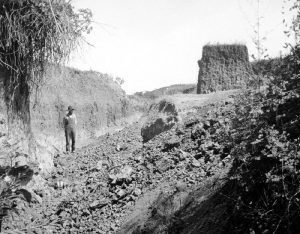
A flash flood in 1908 exposed this archaeological site near Folsom, New Mexico. The site was named for the nearby town of Folsom.
Four years later, Shwahiem showed the Colorado Museum of Natural History the site George had discovered. To recover bison antiques for display, the museum excavated the site in 1926 and revealed something amazing. During the dig, archaeologists found a stone projectile point lodged in the ribs of one of the extinct bison. The Bison and gone extinct during the last Ice Age. Finding a man-made point associated with the 8000-year-old skeleton turned out to be the greatest archaeological find of the 20th century, proving that man had inhabited the North American continent thousands of years before scholars thought.
“It’s a discovery that made him famous, but his courage, determination, and perseverance is what is remembered about the man. A true cowboy!”
Nearly 100 years after his death, George McJunkin took his place beside his fellow legends at the Cowboy Hall of Fame in Oklahoma City, Oklahoma, in April 2019.
© Matt Doherty, submitted July 2019, updated October 2022.
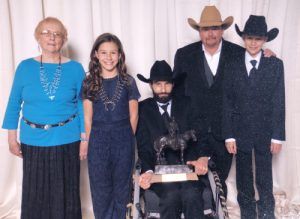
National Western Heritage Museum at George’s induction into the Cowboy Hall of Fame. Left to right: Abbie Reaves, Reagan Doherty, Matt Doherty, Jeff Cornay, Hudson Doherty
About the Author: Matt Doherty is a seventh-generation rancher from the Folsom area of New Mexico. Mcjunkin worked for his Great Great Great Grandfather, Dr. Thomas Owen. Doherty’s family also owns the Doherty Mercantile building, which houses the Folsom Museum, where he sits on the board of directors. It is through these two sources that Doherty put together this biography. Doherty accepted McJunkin’s induction into the Cowboy Hall of Fame at the National Cowboy & Western Heritage Museum in Oklahoma City.
Editors Note – George McJunkins’ birth date is listed as the year 1856 on his gravestone; however other sources place it as 1851. He died on January 21, 1922.
Also See:
Cowboys on the American Frontier

